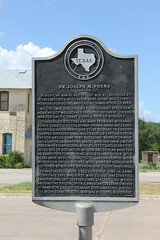Dr Joseph M. Pound
Commemorated on 3 plaques
Texas Historical Marker #10248
Camp Ben McCulloch No. 946, United Confederate Veterans. Hays County Confederate veterans and their families gathered for a reunion in the summer of 1896 and formally organized the Camp Ben McCulloch Chapter of the United Confederate Veterans. The gathering took place near this site at the Martin Spring and campsite on Onion Creek. The reunion grounds were purchased by the organization in 1904 and have continued as the site of the annual reunion with the exception of one year during World War I. The first commander of Camp Ben McCulloch was Capt. Martin Luther Reed. Other officers elected at the first meeting were Jacob C. Quick, W. M. Weaver, W. W. Davis, W. T. Chapman, Dr. J. M. Pound, and Santa Anna Cruze. The camp was named for Confederate General Ben McCulloch, also a veteran of the Texas Revolution, who died in the Battle of Pea Ridge, Arkansas, in 1862. The reunion grounds and other responsibilities were transferred to the care of the Confederate Sons after Burl Nash, the last veteran in the county died in 1947 at age 108. The Sons in turn deeded the camp to the grandsons and other descendants of the Confederate veterans. Reunions continue to be held, illustrating the ongoing impact of the Civil War on Texas history. Texas Sesquicentennial 1836 - 1986 #10248
?, Driftwood, TX, United States where they was near
Texas Historical Marker #10312
Dr. Joseph M. Pound. (1827-1914) In Mexican War at age 19. Got M.D. at Louisville, Ky. In 1853 settled 2 miles from here. Home was clinic-hospital for young and old, rich and poor of area. As Civil War surgeon, he took scarlet fever. Sent home, he got well, joined frontier regiment. (In this war, for each combat death, 2 died of disease.) Confederate doctors had many problems with drug supply, surgical tools, horse-drawn ambulances and hospitals. Instruments had to be bought in Europe (shipped through naval blockage) or captured from the foe. Drugs came in by blockade-runner or were brought from North by ladies who hid them on the person: in Pompadours, bustles, petticoats. Scarcities led to use of dogwood, willow and poplar bark tea as substitute for quinine. Mullein and other wild herbs were medical substitutes. Garden poppies were milked for opium. Sutures were made of horsehair softened by boiling or from silk cloth ravelings. Female nurses were used for first time in army hospitals. This was first was to use anesthetics. Amputations left severed limbs stacked like wood around the field hospitals. Ambulances seemed never at hand for casualties; many died awaiting aid. Till the atom bomb, the Civil War was history's bloodiest. #10312
?, Dripping Springs, TX, United States where they lived near
Texas Historical Marker #14779
Dr. Joseph M. Pound Homestead Pioneer settlers Dr. Joseph M. Pound and his wife Sarah Dunbiken Ward lived here and raised nine children. Two log pens made of rough-hewn cypress logs were built in 1854 with slave labor. Additions were added over time with clapboard and board-and-batten siding and square nail construction. The house featured four cut limestone fireplaces. Circuit riders stopped here and conducted Methodist worship services. The sick and wounded, rich or poor, came to this home as to a hospital. Dr. Pound, a U.S. Army Private in the U.S.-Mexican War, was a Confederate Surgeon in the Civil War. Recorded Texas Historic Landmark-1965 #14779
?, Dripping Springs, TX, United States where they lived


